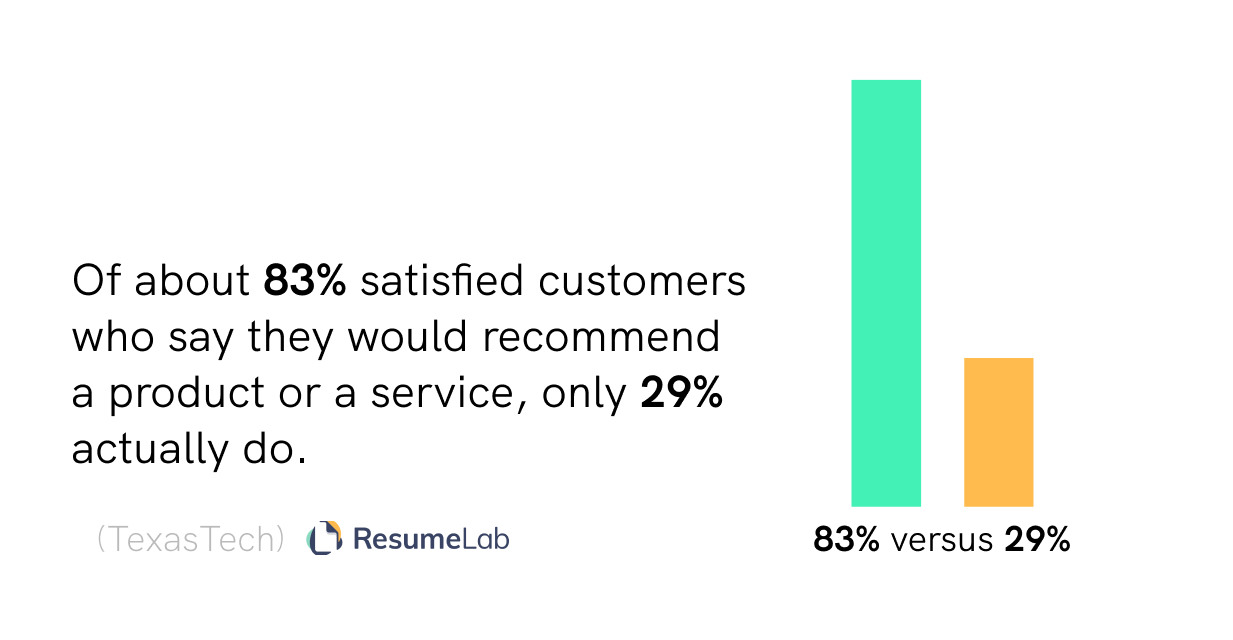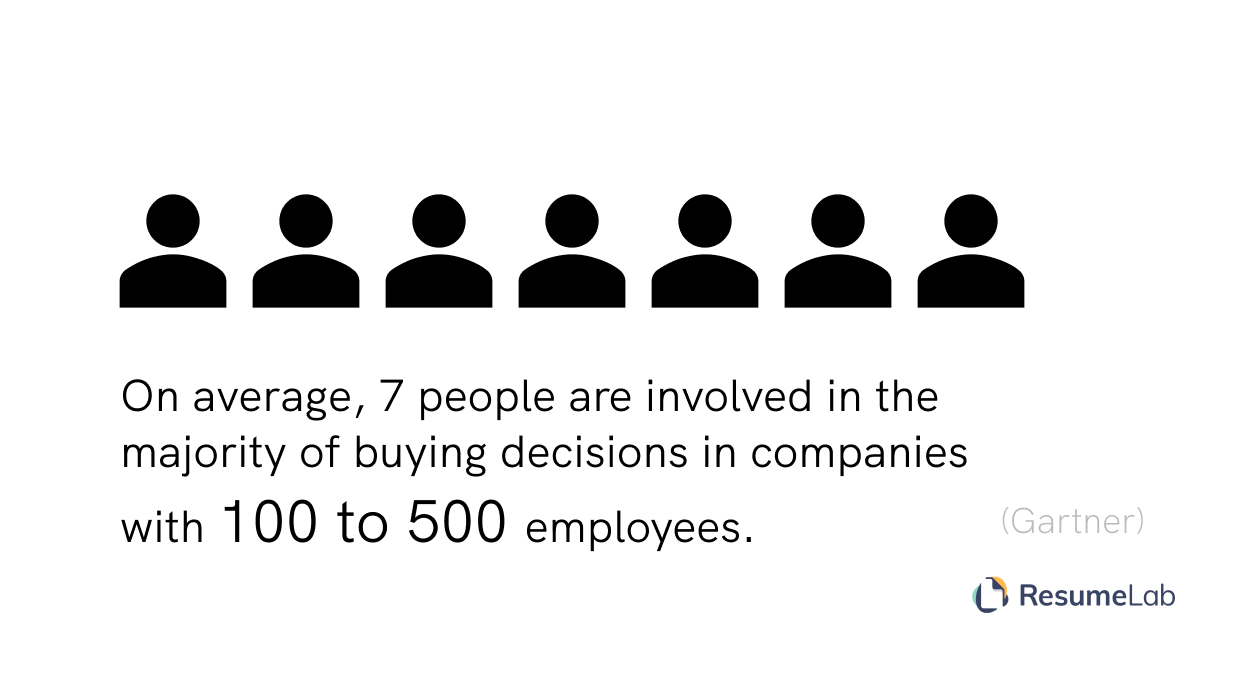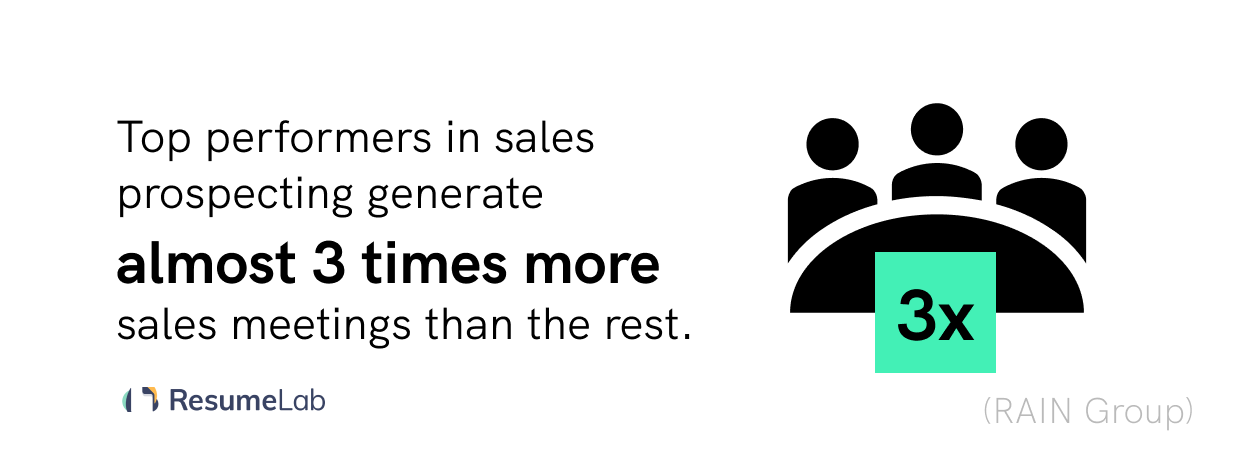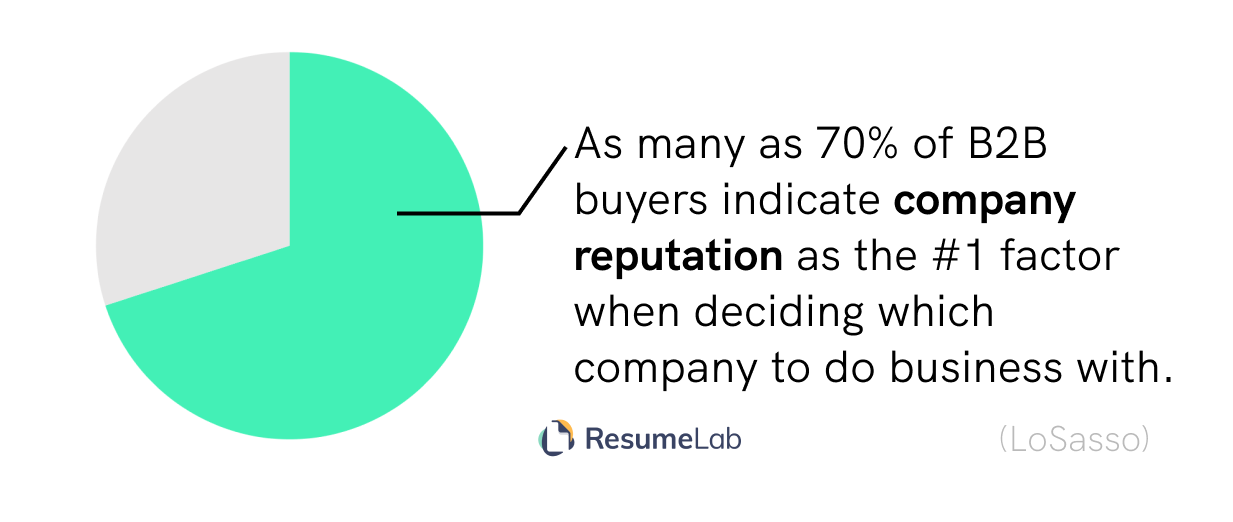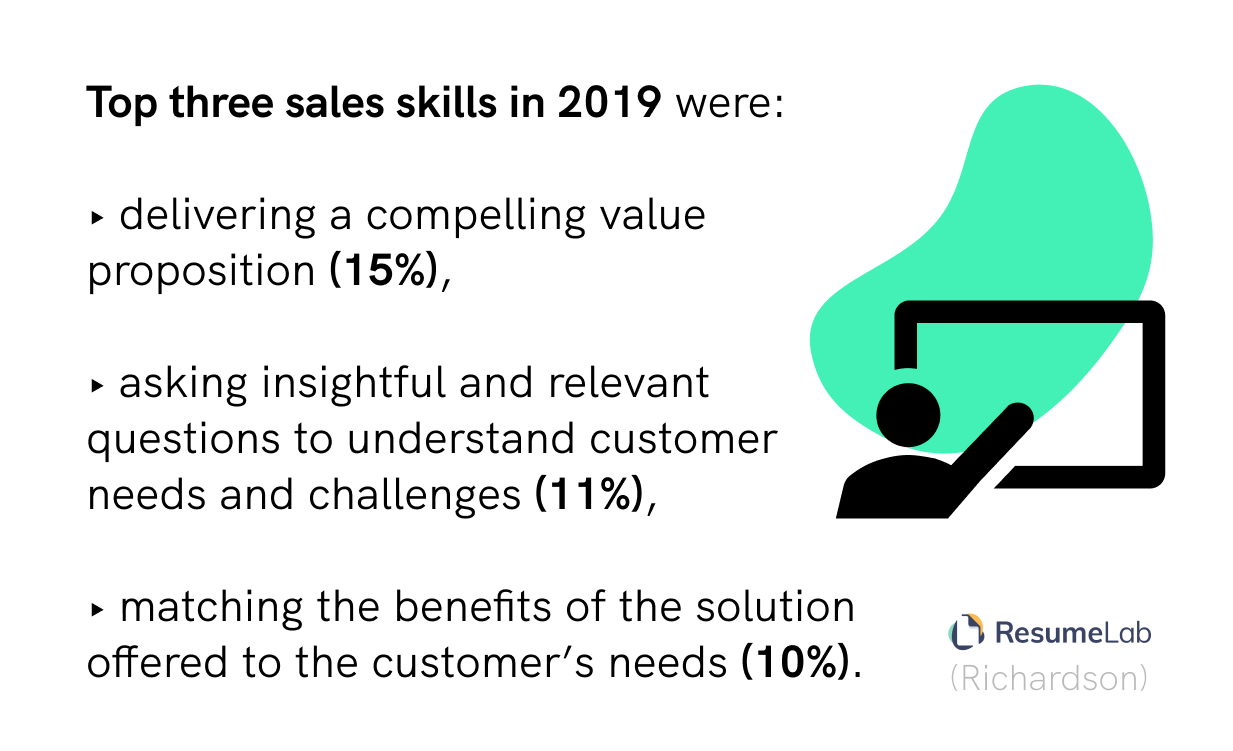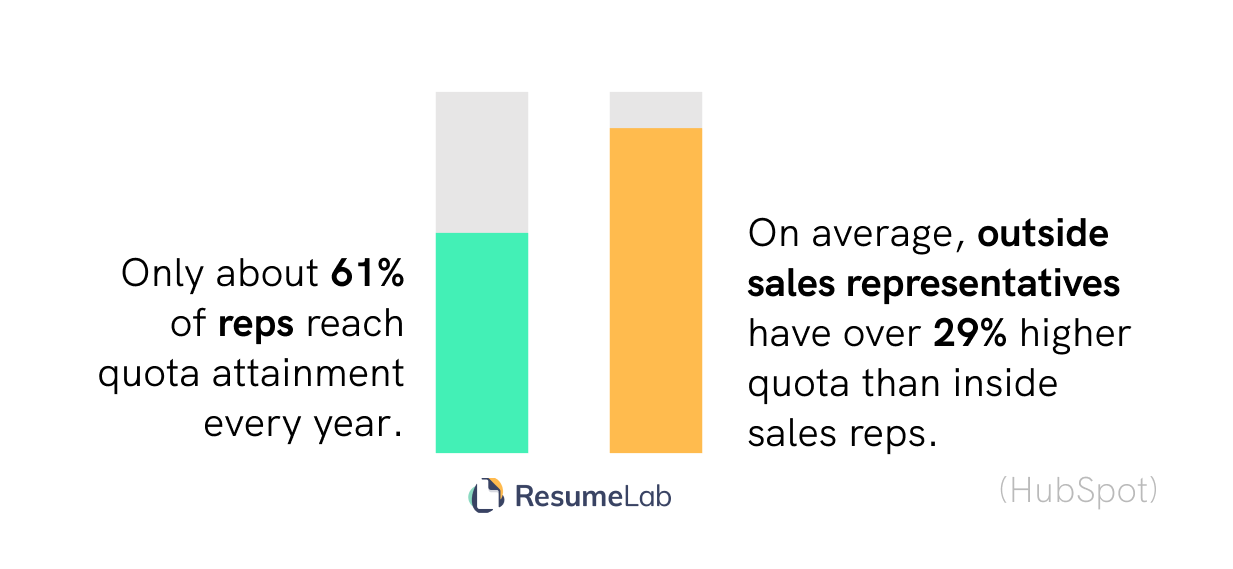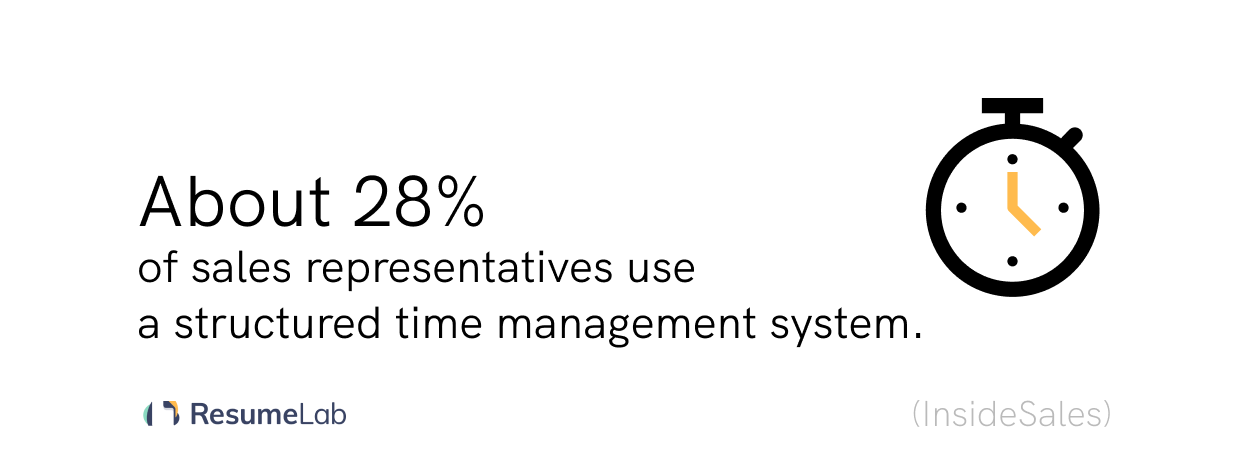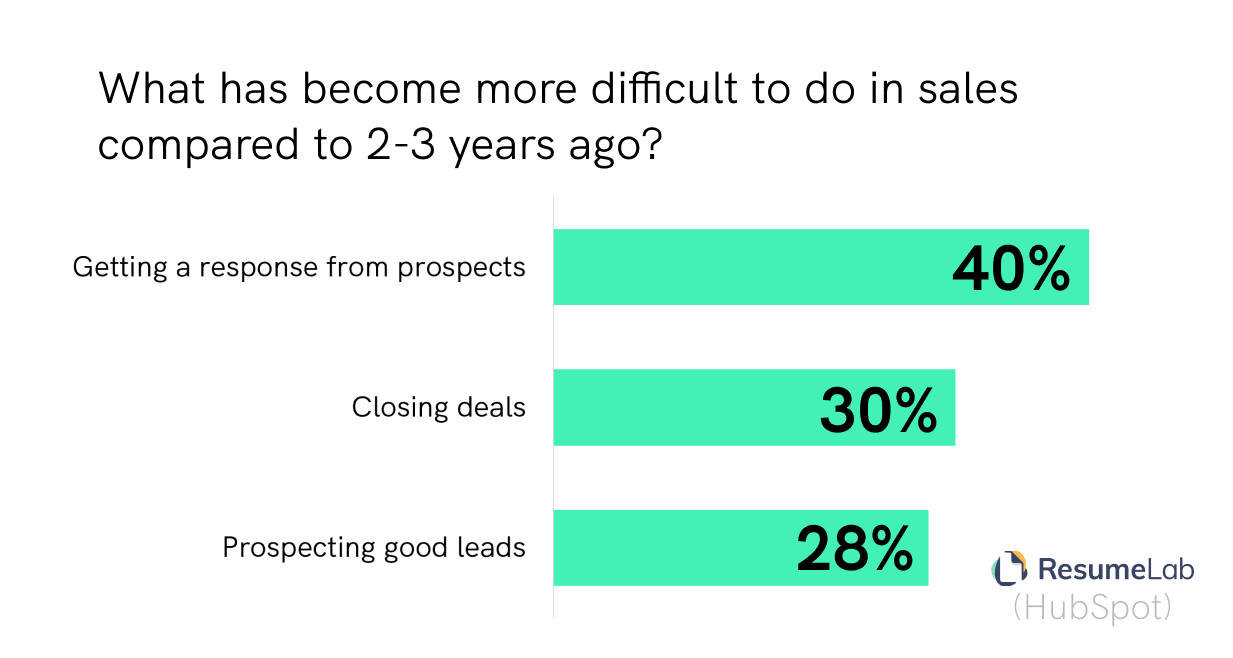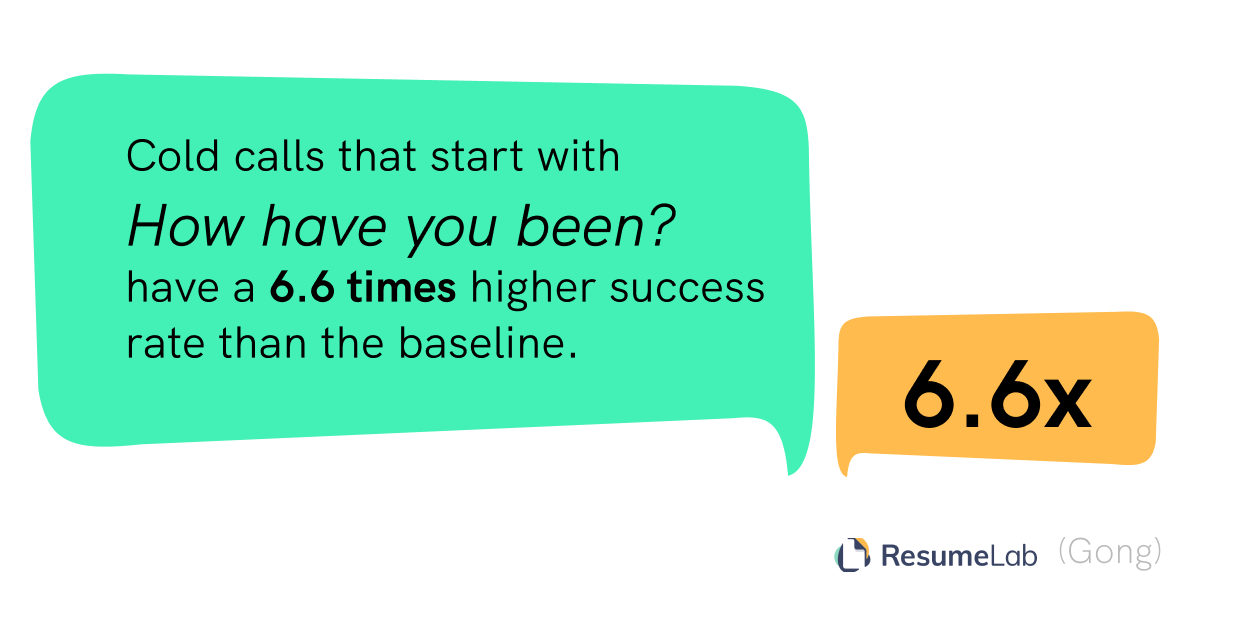Businesses exist to help us solve problems. If we had no problems at all, no business would be really necessary. But businesses have problems of their own too. The biggest one is finding people willing to pay for the solutions a business offers.
This “problem” is called sales. The sales statistics we’ve compiled below come from a variety of independent sources and refer to different aspects of the sales process.
Sales Statistics—Overview
The sales statistics grouped below present a general overview of sales in numbers.
- About 58% of sales teams will be increasing in size this year. (HubSpot)

- Of about 83% satisfied customers who say they would recommend a product or a service, only 29% actually do. (TexasTech)
- Companies spend $15 billion each year on training sales employees and $800 billion on incentives to retain sales talent in the US alone. (LinkedIn)
- The average buyer’s circle is now 6.8 people. (LinkedIn)
- 88% of decision-makers maintain that sales professionals are trusted partners. (LinkedIn)
- Marketing budgets are suspected to grow by almost 9% in 2020. (TheMarketingBlender)
- About 73% of Millennial employees participate in making purchasing decisions for their companies. (Merit)
- Millennial B2B buyers indicated search engines and the company’s official website as the top two ways of researching products and services. (Merit)
- More than 45% of B2B technology buyers are aged between 25 and 34, which makes them the largest demographic. 35- to 44-year-olds make up the second-largest age group (30%). (TrustRadius)
- About 65% of Millennials admit the technologies they buy for personal use influence the choice of technologies they buy for their organization. (Spiceworks)
- Currently, about 67% of the buyer’s journey takes place in the digital format. (Sirius Decisions)
- Roughly 63% of consumers have to hear company claims 3 to 5 times before believing them. (Edelman Trust Barometer)
- About 63% of consumers believe that marketing actions are a waste of time as they’re trying to force prospects into paying attention rather than make them want to pay attention. (LoSasso)
- About 55% of B2B buyers search for product and/or service information on social media channels. (Biznology)

- On average, 7 people are involved in the majority of buying decisions in companies with 100 to 500 employees. (Gartner)
- Nurtured leads generate 47% larger purchases than non-nurtured leads. (The Annuitas Group)
- Almost 85% of CEOs and VPs fall back on social media when making purchasing decisions. (Source IDC)
- About 80% of business decision-makers would rather get company info from articles than advertisements. (B2B PR Sense Blog)
- On average, B2B buyers are almost 60% into the buying decision before engaging with sales. (CEB)
- About 53% of sales reps meeting or exceed their quotas. This is the 5th straight year of decline. (CSO Insights)
- As many as 91% of customers admit they’d give referrals. However, just 11% of sales professionals ask for them. (Dale Carnegie)
Long, Hard Road Out to Sell—Sales Process Stats
The sales process itself is one of the most demanding and complex processes in modern business. The sales stats in this section are where the customer’s journey, marketing, and sales efforts meet. They show how many cogs have to function in sync for the sales machine to bring about the desired results.
- Over 80% of buyers accept meetings with sellers who reach out to them proactively. (RAIN Group)

- Top performers in sales prospecting generate almost 3 times more sales meetings than the rest. (RAIN Group)
- Over 70% of buyers would like to hear from sellers at the early stages of the buying process. (RAIN Group)
- About 70% of sales professionals admit they’re most active on LinkedIn for business purposes. Almost 90% of top sales performers report that networking platforms are very important or important. (LinkedIn)
- About 93% of prospects are more likely to engage if a salesperson provides personalized communications. Almost 80% of buyers won’t engage with sales reps who lack knowledge of their company. (LinkedIn)
- Top sales professionals are 13% more likely to be closely engaged with marketing. About 64% of them say leads from marketing are either excellent or good. Almost 90% of decision-makers say consistent messages from sales and marketing is important. (LinkedIn)
- Millennials are 23% more likely than GenXers to admit they work very closely with the marketing department. They are also 73% more likely than Baby Boomers to be working very closely with marketing. About 19% of Millennials surpassed their sales targets by over 50%. In contrast, only 13% of GenXers and Baby Boomers did. (LinkedIn)
- Roughly 70% of customers define their needs before engaging with a sales professional. About 44% find specific solutions before they reach out to a salesperson. (CSO Insights)

- As many as 70% of B2B buyers indicate company reputation as the #1 factor when deciding which company to do business with. (LoSasso)
- About 62% of people who want to learn more about a product or service go to a search engine. Over 40% of those who are ready to buy go to the search engine too. Official company websites are visited by 48% of those who want to learn more, and 41% of those ready to buy. Official newsletters and emails from the company appeal to 37% of those who want to learn more and to about 23% of those who are ready to buy. In-person events are the preferred choice of about 35% of those who want to learn more and 29% of those ready to buy. Finally, word-of-mouth is the way to go to about 33% of those who want to learn more and 30% of those who are ready to buy. (HubSpot)
|
The type of content people desire when they’re looking for more information on the product/service or are ready to buy.
|
| |
Want to learn more
|
Ready to buy
|
|
Product information, features, and functions
|
57%
|
51%
|
|
Product ratings and reviews
|
52%
|
48%
|
|
Peer experiences
|
42%
|
41%
|
|
Customer case studies
|
42%
|
36%
|
|
Demos
|
38%
|
36%
|
(HubSpot)
- About 58% of customers are interested in discussing the pricing of the product in the first sales call, 54% want to talk about how the product works, and 47% what their company is trying to achieve with the product. On the other hand, among sales reps 23% want to discuss the product’s pricing, the same number want to talk about how the product works, and 65% about what the company is trying to achieve with the product. Also, 63% of them are ready to discuss why the company needs to make the purchase. (HubSpot)
- As many as 60% of people are ready to talk to a sales rep after they’ve done their research and have shortlisted the products they’re considering buying. About 19% are willing to talk to a sales representative when they’re first learning about the product. (HubSpot)
- Almost 14% of people regard the information and advice about a product they get from customer service teams as very trustworthy. Only about 7% think the same about what they hear from sales representatives. (HubSpot)
- Almost 70% of people admit their sales experience would improve if sales representatives listened to their needs, 61% if the sales rep weren’t pushy, and provided relevant information. (HubSpot)
- 83% of sales representatives say they listen to their prospect’s needs, 77% say they try to be helpful, and 74% say they research their prospect before calls. Also, 71% say they tailor their pitch on the basis of their customer’s needs. (HubSpot)
- 84% of buyers with negative experience encountered sales representatives that were pushy, 62% came across sales reps that didn’t listen to their needs, and 45% say that sales didn’t research them before the calls. Plus, 44% claim sales didn’t try to be helpful and 37% say the pitch wasn’t tailored to their needs. (HubSpot)

- Top three sales skills in 2019 were delivering a compelling value proposition (15%), asking insightful and relevant questions to understand customer needs and challenges (11%), matching the benefits of the solution offered to the customer’s needs (10%). (Richardson)
- Millennials (whose expectations for personalization are particularly high) will make up 46% of professionals by 2020. (LinkedIn)
- About 96% of decision-makers admit they’re more likely to consider a brand’s products or services if sales professionals have a good understanding of their business needs. (LinkedIn)
- Only about 20% of sales pros report a meaningful overlap in the data used by marketing and sales to target leads. (LinkedIn)
- About 40% of sales professionals rank trust as the #1 factor in closing deals and over 50% of decision-makers consider trust the top factor they desire in a salesperson. (LinkedIn)
- Roughly 70% of sales professionals admit they’re most active on LinkedIn for business purposes, compared to social media platforms like Facebook (64%), Twitter (43%), YouTube (41%), and Instagram (39%). (LinkedIn)
- Top factors that influence decision-makers in an initial sales engagement are representing a well-known company with a strong brand (52%), giving specific information relevant to the decision maker’s current job (47%), mentioning the sales rep’s company and product solutions (41%), referencing a mutual colleague (39%), and having a strong charisma (32%). (LinkedIn)
- Almost 90% of decision-makers admit that consistent marketing and sales language about a product is very important (50%) or important (39%). Almost 50% state they often or always experience different messaging from sales and marketing when learning about a solution. (LinkedIn)
- About 62% of Millennials (and 65% of top performers) assume they’ll be using sales technology more this year compared to the previous one. Roughly 56% of Generation X and Baby Boomers expect to be investing more time this year than last year. (LinkedIn)
- Around 66% of decision-makers believe the sales professionals they work with are essential partners all or most of the time. (LinkedIn)
- More than half of decision-makers rank trust as the #1 factor they want to see in a salesperson. This is followed by responsiveness (42%), expertise (42%), problem-solving (37%), and transparency (34%). (LinkedIn)
- 99% of sales professionals admit that trust is either very important or important to winning new business. 40% rank trust as the most important factor in closing a deal, even above ROI of the product or service (28%) and price (18%). (LinkedIn)

- Over 70% of B2B buyers are most likely to share useful content via email. (Earnest Agency)
- Almost 35% of B2B buyers admit their purchase decisions are mostly motivated by features, while 27% say they’re driven by the price and 39% say it’s the brand. (LoSasso)
- Over 65% of B2B buyers stated that discussing their situations with salespeople was valuable. (CSO Insights)
- More than 45% of B2B buyers wish to hear new ideas at the start of a sales pitch. (CSO Insights)
- 9 out of 10 B2B buyers maintain that online content has a moderate to major effect on their purchasing decisions. (CMO Council)
- Sales processes today take 22% longer than 5 years ago. (Biznology)

- Top performing sales professionals use LinkedIn 6 hours a week to research prospects, make connections with peers, interact with industry-related groups, and publish content. (Jill Konrath)
- Over 80% of B2B decision-makers believe that sales reps are unprepared. (Biznology)
- About 68% of B2B customers are lost because of the sales rep’s indifference or apathy. Just 46% of customers said vendors deliver on their promises. (Gallup)
Inside, Outside—Must Have Done a Dozen Each
Sales can be done from the comfort of your office or you may have to travel and meet your prospects in person. How do these two modes of sales translate into numbers? The sales statistics below will show you exactly how.
- Out of the 5.7 million professional salespeople in the US, about 46% are inside sales professionals. Outside sales represent 53%. (LinkedIn)
- Outside sales reps spend about 46% of their time selling remotely. (Xant)
- Large organizations (w/revenue > USD 500M) are dominated by field sales reps (71.2%). Small organizations (w/revenue < USD 50M) have the highest percentage of inside sales reps (47%) (Xant)
- The average base salary for inside sales account executives in the US is USD 42,833 with average on-target earnings (OTE) of USD 96,299. Companies whose sales reps were mostly outside had a base salary 36% higher than inside sales. Interestingly, the OTE for outside sales was only 9.2% higher. (HubSpot)

- Only about 61% of reps reach quota attainment every year. On average, outside sales representatives have over 29% higher quota than inside sales reps. (HubSpot)
- Sales organizations consisting mostly of inside sales representatives made almost 43% more dials, left over 10% more voicemails, and sent almost 9% more emails than organizations with primarily outside sales representatives. In addition, they focused more on social media, with 49% more social touches than outside sales reps. (HubSpot)
- Companies whose sales teams are dominated by inside sales reps have almost 10% higher quota attainment than companies with mostly outside sales reps. (HubSpot)
- Companies consisting primarily of outside sales reps have over 30% higher close rates than companies with a majority of inside sales reps. (HubSpot)
- Deals achieved by outside sales were over 130% larger on average than those achieved by inside sales teams. (HubSpot)
Time is Always Passing By—Sales Time Stats
How do sales professionals plan and spend their time? The sales statistics in this section will give you a glimpse.

- About 28% of sales representatives use a structured time management system. (InsideSales)
- Sales representatives spend about 37% of their time on revenue-generating activities. (InsideSales)
- About 18% of sales representatives’ time is allocated to using a CRM (customer relationship management system), 62% of their time is consumed by the use of sales technology, and almost 10% of the time is taken up by using spreadsheets to help sales reps do what they wish would be possible using CRM. (InsideSales)
- About 25% of reps spend between 0-30 minutes on data entry, 35% between 31-60 minutes, 19% between 61-120 minutes, and 8% over 120 minutes. (InsideSales)
I’ve Got My Mind Set on You—Sales Priorities Stats
What do sales priorities for companies and sales departments look like? Here’s a quick look at sales statistics on these exact things.
- The top sales priorities for companies in 2019 were closing more deals (75%), improving the efficiency of the sales funnel (48%), reducing the length of the sales cycle (32%), and social selling (28%). (HubSpot)
- The top three marketing priorities for companies in 2019 were converting contacts/leads to customers (69%), growing website traffic (54%), and increasing revenue from existing customers (44%). (HubSpot)
No Pleasure Cruise—Sales Pro’s Challenges
Sales is tough—that’s common knowledge. But what kind of challenges exactly does sales entail? The sales statistics below show what kind of hurdles sales professionals have to clear.
During the sales process, sales reps struggle most with:
- Prospecting (37%)
- Closing (28%)
- Identifying the lead (18%)
- Qualifying 17%
(HubSpot)

What has become more difficult to do in sales compared to 2-3 years ago?
- Getting a response from prospects (40%)
- Closing deals (30%)
- Prospecting good leads (28%)
(HubSpot)
- To 42% of sales reps, it’s challenging to establish a sense of urgency with their prospects (i.e. getting them to buy now rather than later). About 37% of sales reps say it’s hard to connect with their prospects, and 35% admit their prospects struggle with the product’s price. (HubSpot)
- Almost 25% of sales representatives anticipate that creating value and insights for clients will be a major challenge. 22% say that building a case for change is a top sales challenge. (Richardson)
- The top three prospecting challenges in 2019 were gaining appointments (14%), maintaining a consistent cadence of contact across multiple channels (12%), getting to the right stakeholder (12%). (Richardson)
- Top three challenges with uncovering client needs in 2019 were creating value and insight during the conversation with the client (22%), overcoming the buyer’s misperceptions of what they need (15%), and exploring client issues to define the strategic impact of offered solution (14%). (Richardson)
- The top three challenges with negotiating in 2019 were maintaining profitability (17%), working with clients who continue to reopen the negotiations (15%) and gaining higher prices (13%). (Richardson)
- The top three challenges facing buyers in 2019 were building a case for a change (22%), comparing options (21%), combating the status quo (19%). (Richardson)
- The top three challenges managing accounts in 2019 were becoming a trusted advisor (16%), finding ways to add relevant value for various stakeholders (11%), balancing sales and relationship management (11%). (Richardson)
Needle in a Haystack—Sales Prospecting Stats
In the sales lingo prospecting means identifying potential customers. This is often one of the most important stages of the entire sales process. The sales stats below will give you a glimpse into what prospecting is really about and how demanding it is.

- The most successful channel for sales reps to connect with a prospect is the telephone (36%), followed by e-mail (30%), and LinkedIn (12%). (HubSpot)
- The top source of leads for sales are referrals (32%) and marketing (28%). (HubSpot)
- The three most reliable sources of information when making purchasing business software are word of mouth (friends, social media) (55%), customer references (46%), and media articles (38%). (HubSpot)
- The best day for calling your prospects is a Wednesday. (CallHippo)
- The best hours for calling your prospects is 4-5 PM. If you can’t do this, the 2nd best time slot is between 11-12 AM. (CallHippo)

- You should try and call a prospect at least 6 times. (CallHippo)
- The best time for calling a prospect is within 1 hour after they showed interest in a product or service of yours. (CallHippo)
- Once your prospect answers the phone, you have 5 seconds to earn 5 minutes. (Gong)
- On average a successful cold call is 5:50 minutes long. An unsuccessful one lasts 3:14 minutes on average. (Gong)
- The average sales rep only makes two cold call attempts. (Sirius Decisions)
- Just about 2% of cold calls lead to an appointment. (Leap Job)
With a Little Help From Technology
Modern technologies can streamline sales processes. But how many sales professionals use them and how helpful can technological solutions be? The sales statistics in this section will give you the answers.
- If used correctly, a CRM can improve productivity by 30%, (Salesforce)
- 73% of salespeople use technology to close more deals. (LinkedIn)
- The adoption of CRM software has grown by 113%—more than doubling since 2016. (LinkedIn)
- More than 50% of CRM users adopted the system within the first five years of the company’s launch. Over 60% of them had at least 100 customers when they first purchased a CRM system. (Capterra)
- 75% of the CRM market is dominated by Microsoft, Oracle, SAP, and Salesforce. Over 30% of CRM users use Salesforce. (Capterra)

- Businesses spend about $150 per user per month on their CRM systems. Over 60% spend about $50 per user per month. (Capterra)
- The most desired CRM features include social media monitoring capabilities (25% of CRM users) and the ability to fetch prospect information from social media (24% of CRM users). (Capterra)
- CRM software had the biggest impact on customer retention and satisfaction rates. (Capterra)
- About 73% of sales professionals use sales technology to close more deals. Top sales performers (i.e. those who close deals at a 51% higher rate than their peers) perceive networking platforms as very important to their success. (LinkedIn)
- About 64% of sales professionals use CRM tools like Salesforce and Microsoft Dynamics, which is up 28% from 2017. Over 60% use collaboration tools like Box, Google Docs, Microsoft Office and Dropbox— this is a 6% rise from 2017. Also, 40% use enterprise communication platforms (that’s 8% more since 2017). (LinkedIn)
Language as a Sales Tool
Even though technology could be of some help, at the end of the day the most powerful tool that every sales professional has at their disposal is language. The choice of words is crucial in persuading a prospect to eventually become a customer. The sales statistics we put together here show the power of language as a sales tool.
- If you use these words 4 or more times during any sales call, close rates will drop:
- We provide by 22%
- Absolutely and perfect by 16%
- Your company name by 14%
- Show you how by 13%
(Gong)
- The word discount used during sales calls decreases the likelihood of closing by 17%, the word contract decreases close rates by 7% from the average. The word free trial causes a 5% drop in the likelihood of making it to the next step. (Gong)
- The phrase Did I catch you at a bad time? at the start of a cold call renders you 40% less likely to book a meeting. (Gong)

- Cold calls that start with How have you been? have a 6.6 times higher success rate than the baseline. (Gong)
- Starting your call with the reason for calling boosts your success rate by 2.1 times. (Gong)
- The optimal talk-to-listen ratio of a successful cold call is 55-45. (Gong)
- In successful cold calls, the average length of a buyer’s monologue is 3.5 seconds; in unsuccessful ones, it’s 8 seconds long. Also, in successful calls, there are 77% more “speaker switches per minute” than in the unsuccessful ones. (Gong)
- In successful cold calls, the we-to-I ratio is 35% higher than in unsuccessful ones. (Gong)
The Importance of Building Relationships
With the advent of social media, sales entered the era of enhanced social selling—a sales process based on developing relationships. Currently, it’s often present in social networks, e.g. Facebook, LinkedIn, Twitter, Instagram, or Pinterest. However, it can take place both online and offline.
- Over 60% of organizations practicing Social Selling report a positive impact on revenue growth. (SalesForLife)
- Over 70% of sales professionals believe that they aren’t proficient with Social Selling. (SalesForLife)
- Almost 75% of companies want to increase the use of Social Selling by their sales teams over the next 12 months. (SalesForLife)
Interested in more stats? Check out our HR statistics post.
What do you think about the sales statistics we’ve compiled here? Have you found anything surprising? Would you like to share some sales stats with us? We’d love to hear from you. Give us a shout out in the comments below.
About Us
ResumeLab is an all-in-one tool for job seekers. Using our resume creator and cover letter generator, you can craft a perfect job application. They come with dedicated resume templates & cover letter templates that match in style for a bigger impact.
Besides that, you can find multiple comprehensive guides that will help you during the creation process. You can learn what is ATS resume, how to write a cover letter, or what is the best resume layout. Browse our website to see more.
![Gig Economy: Statistics and Definition [2020 Trends Update]](https://cdn-images.resumelab.com/pages/gig_economy_statistics_rl_listing.jpg)

![150 Sales Statistics—Prospecting, Calls, & More [2020 Update]](https://cdn-images.resumelab.com/pages/sales_stats_hero.jpg)
